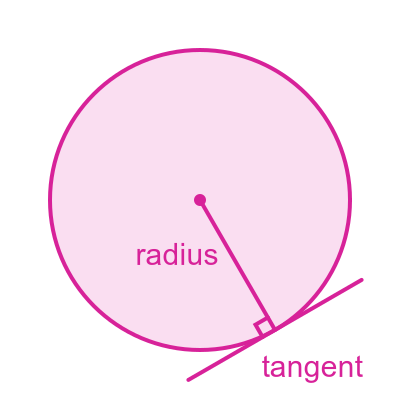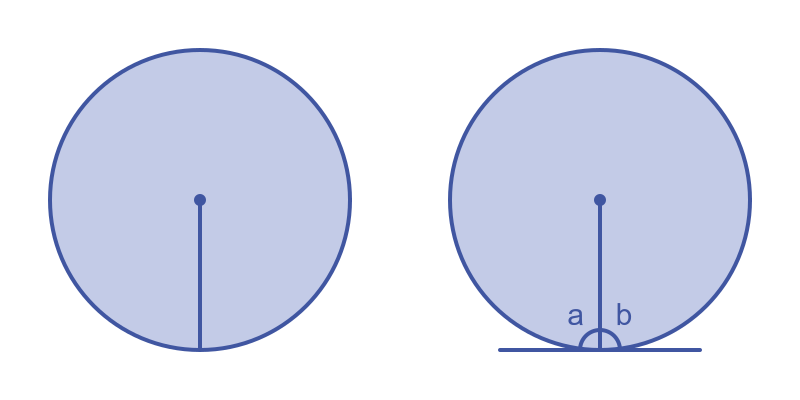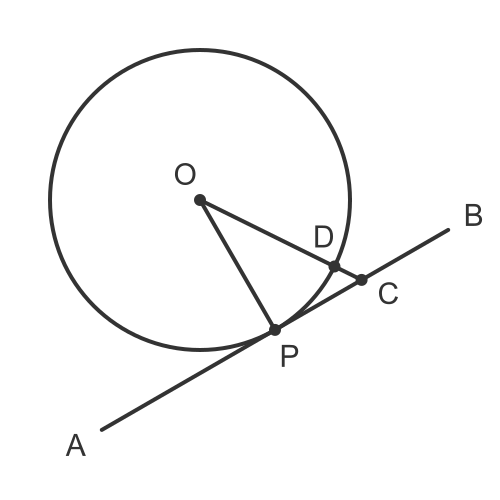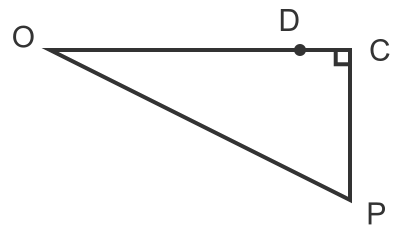Tangent and radius of a circle meet at 90°
Categories: gcse geometry circle geometry
Level:

A tangent is a line that just touches the circle at a single point on its circumference.

If we draw a radius that meets the circumference at the same point, the angle between the radius and the tangent will always be exactly 90°.
This theorem is covered in this video:
Why is this true?
Before we prove this theorem, it is interesting to try to understand why it might be true. We can use symmetry to help us to understand this.

When we draw a radius vertically (circle on the left), the diagram is symmetrical. The left half of the circle is a mirror image of the right half.
If we add a tangent (circle on the right), then the radius meets the tangent forming an angle a on the left and b on the right.
Which angle is bigger? Is a greater than b, or is b greater than a? Well, the diagram is symmetrical, so there is no reason to assume that either a or b is bigger. It seems reasonable to assume that the two angles are equal. Since a and b add to make a straight line they must each be 90 degrees.
So the angle between the radius and tangent is 90 degrees.
This is not a proof, it is just a way of convincing ourselves that it is probably true. The proof is next.
Proof
You aren't required to learn this proof for GCSE, but if you are interested it is included here. This proof was found by Euclid more than 2000 years ago!
We want to prove that the angle between the radius OP and the tangent AB is a right angle.
We will use proof by contradiction. This means that we will start by assuming that the statement is not true. This will lead to a contradiction, proving that it is impossible for the statement to be not true, which means it must be true.
So we start with the assumption that the line OP does not meet the line AB at a right angle.
There must be some other line from O that meets the line AB at a right angle. It meets the line AB at some point C. Here is a diagram:

Since the circle only touches the tangent in one place, point P, it follows that the line OC must cross the circle at some point. We will call that point D.
We have deliberately chosen point C such that the angle OCA is a right angle. So we can now draw just the triangle on its own:

One thing to notice here is that the lines OD and OP are both radii of the circle, so they both have equal lengths. Since the line OC clearly longer than OD, it must also be longer than OP
But this is an impossible triangle, because:
- Angle C is the right angle, so side OP must be the hypotenuse.
- The hypotenuse, OP of a triangle is always the longest side.
- But we know that OC is always longer than OP.
This is a contradiction. It means that it is impossible for line OC to meet line AB at a right angle.
Now C can be placed anywhere on the line AB except at position P. But wherever we place it, the angle ACB cannot be a right angle.
There must be a line from O that meets AB at a right angle, and it can't be at any position C that isn't P, so it must be at position P.
OP is the radius, and AB is the tangent, and we have proved that they meet at a right angle.
Related articles
- Parts of a circle
- Perpendicular bisector of chord theorem
- Angle at the centre of a circle is twice the angle at the circumference
- Angle in a semicircle is 90°
- Angles in the same segment of a circle are equal
- Opposite angles in a cyclic quadrilateral add up to 180°
- Two tangents from a point have equal length
- Alternate segment theorem
- Two radii form an isosceles triangle
Join the GraphicMaths Newsletter
Sign up using this form to receive an email when new content is added to the graphpicmaths or pythoninformer websites:

Popular tags
adder adjacency matrix alu and gate angle answers area argand diagram binary maths cardioid cartesian equation chain rule chord circle cofactor combinations complex modulus complex numbers complex polygon complex power complex root cosh cosine cosine rule countable cpu cube decagon demorgans law derivative determinant diagonal directrix dodecagon e eigenvalue eigenvector ellipse equilateral triangle erf function euclid euler eulers formula eulers identity exercises exponent exponential exterior angle first principles flip-flop focus gabriels horn galileo gamma function gaussian distribution gradient graph hendecagon heptagon heron hexagon hilbert horizontal hyperbola hyperbolic function hyperbolic functions infinity integration integration by parts integration by substitution interior angle inverse function inverse hyperbolic function inverse matrix irrational irrational number irregular polygon isomorphic graph isosceles trapezium isosceles triangle kite koch curve l system lhopitals rule limit line integral locus logarithm maclaurin series major axis matrix matrix algebra mean minor axis n choose r nand gate net newton raphson method nonagon nor gate normal normal distribution not gate octagon or gate parabola parallelogram parametric equation pentagon perimeter permutation matrix permutations pi pi function polar coordinates polynomial power probability probability distribution product rule proof pythagoras proof quadrilateral questions quotient rule radians radius rectangle regular polygon rhombus root sech segment set set-reset flip-flop simpsons rule sine sine rule sinh slope sloping lines solving equations solving triangles square square root squeeze theorem standard curves standard deviation star polygon statistics straight line graphs surface of revolution symmetry tangent tanh transformation transformations translation trapezium triangle turtle graphics uncountable variance vertical volume volume of revolution xnor gate xor gate
